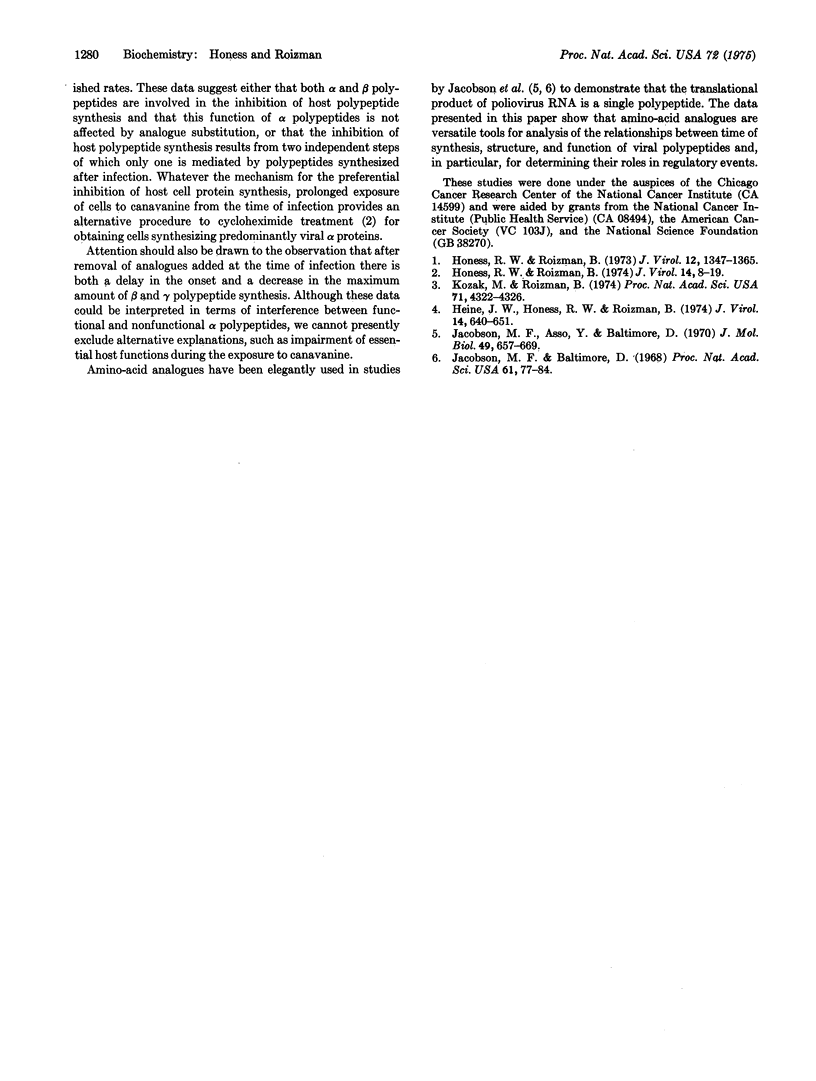Abstract
It was previously shown that virus-specific polypeptides made in HEp-2 cells infected with herpes simplex 1 form three groups designated alpha, beta, and gamma whose synthesis is coordinately regulated and sequentially ordered. This report shows that one or more functional alpha polypeptides are necessary to turn on the synthesis of beta and gamma groups, and conversely, one or more polypeptides in the latter groups turn off the synthesis of alpha polypeptides. Specifically, infected cells maintained in medium containing either canavanine, an analogue of arginine, or azetidine-2-carboxylic acid an analogue of proline and hydroxyproline, synthesized alpha polypeptide at rates comparable to maximal rates in untreated infected cells but did not undergo the normal transition to beta and gamma polypeptide synthesis. The transition to gamma polypeptide synthesis and shut-off of synthesis of earlier polypeptide groups proceeded normally if addition of canavanine was delayed until at least 4-5 hr after infection. Addition of canavanine after the onset of beta and gamma polypeptide synthesis, i.e., between 2 and 3.5 hr after infection, resulted in sustained, simultaneous synthesis of all three polypeptide groups, a phenomenon not seen in untreated infected cells. Canavanine-treated infected cells, synthesizing alpha polypeptides, recovered the capacity to make beta and gamma polypeptides after removal of the analogue, but only after a 1-to 2-hr delay compared with infected untreated cells. The data indicate that the on and off controls inherent in the cascade regulation of viral polypeptide synthesis are mediated by one or more polypeptides in each group at transcriptional or post-transcriptional levels.
Full text
PDF




Images in this article
Selected References
These references are in PubMed. This may not be the complete list of references from this article.
- Heine J. W., Honess R. W., Cassai E., Roizman B. Proteins specified by herpes simplex virus. XII. The virion polypeptides of type 1 strains. J Virol. 1974 Sep;14(3):640–651. doi: 10.1128/jvi.14.3.640-651.1974. [DOI] [PMC free article] [PubMed] [Google Scholar]
- Honess R. W., Roizman B. Proteins specified by herpes simplex virus. XI. Identification and relative molar rates of synthesis of structural and nonstructural herpes virus polypeptides in the infected cell. J Virol. 1973 Dec;12(6):1347–1365. doi: 10.1128/jvi.12.6.1347-1365.1973. [DOI] [PMC free article] [PubMed] [Google Scholar]
- Honess R. W., Roizman B. Regulation of herpesvirus macromolecular synthesis. I. Cascade regulation of the synthesis of three groups of viral proteins. J Virol. 1974 Jul;14(1):8–19. doi: 10.1128/jvi.14.1.8-19.1974. [DOI] [PMC free article] [PubMed] [Google Scholar]
- Jacobson M. F., Asso J., Baltimore D. Further evidence on the formation of poliovirus proteins. J Mol Biol. 1970 May 14;49(3):657–669. doi: 10.1016/0022-2836(70)90289-5. [DOI] [PubMed] [Google Scholar]
- Jacobson M. F., Baltimore D. Polypeptide cleavages in the formation of poliovirus proteins. Proc Natl Acad Sci U S A. 1968 Sep;61(1):77–84. doi: 10.1073/pnas.61.1.77. [DOI] [PMC free article] [PubMed] [Google Scholar]
- Kozak M., Roizman B. Regulation of herpesvirus macromolecular synthesis: nuclear retention of nontranslated viral RNA sequences. Proc Natl Acad Sci U S A. 1974 Nov;71(11):4322–4326. doi: 10.1073/pnas.71.11.4322. [DOI] [PMC free article] [PubMed] [Google Scholar]



